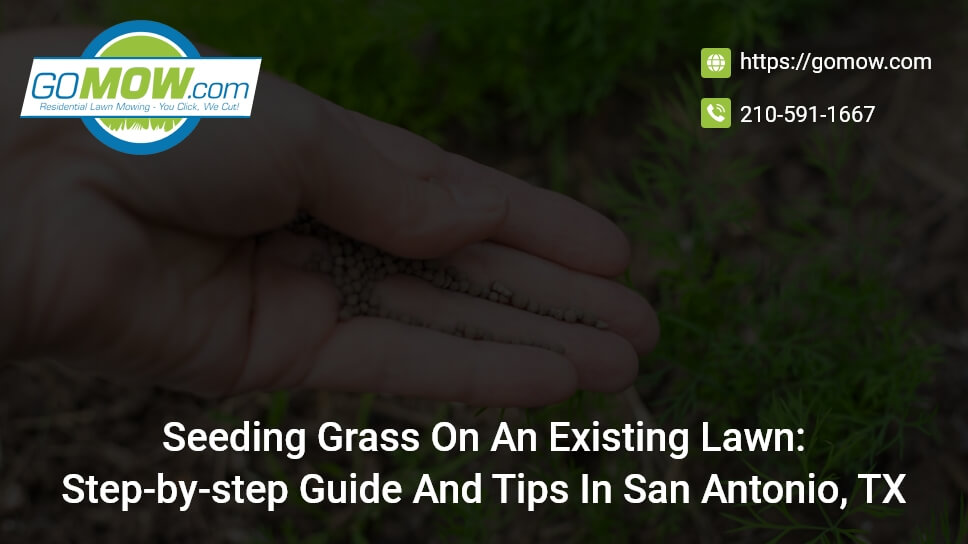Seeding Grass On An Existing Lawn: Step-by-step Guide And Tips In San Antonio, TX

Planting seeds on an existing lawn isn’t rocket science. There are reasons why it happens and in most cases, this is when there has been a disastrous incident on the lawn. Oftentimes, the existing lawn experienced a disease attack or is trying to recover from dormancy.
Whatever the case maybe, lawn services in San Antonio will likely have to come to the rescue to bring such a lawn back to life. If your lawn yard doesn’t look like you would want it to, seeding new grass on it is the way to go.
In this post, we have discussed how lawn maintenance in San Antonio can seed your lawn with fresh seedlings to start a new growth on your lawn. Over-seeding is cheap and effective in rejuvenating dead grass.
Below is a step-by-step guide including tips in lawn care in San Antonio to renew a dying lawn yard. These steps can also serve as a guide to keep a healthy lawn sustainable.
Over-seeding – Meaning
Over-seeding refers to the lawn care action of planting new seedlings over new lawn to trigger new fresh growth of grass on it. Over-seeding is used to correct dead growth of grass on a lawn yard. It can also be used on lawns with patchy growth.
Cold season grass becomes dormant during summer. Warm season grass becomes dormant during winter. Knowing this information will help lawn owners and lawn care services in San Antonio and beyond to make better choices.
Why You Should Overseed Your Lawn With New Seeds
There are several situations where a homeowner will need to overseed their lawns. Some reasons that might necessitate over-seeding include:
- Stop a healthy lawn from falling apart
- Resuscitate a struggling lawn from complete collapse
- Improve the look of a lawn yard ahead of a harsh season like summer or winter
It is important to avoid using pre-emergent herbicides on your lawn in spring if you plan to overseed in summer because such an application will affect your over-seeding activities unless you’re using highly-specific herbicides.
Healthy Lawn Overseeding Process
Even healthy lawns can be overseeded if need be. Overseeding helps the lawn remain healthy for a longer period of time without any decline. The best time to overseed a healthy lawn is during fall season especially when it’s cool season grass.
- Mow the existing grass to 1.5 or 2 inches height before getting started.
- Decide on a cool season grass seedling like Perennial ryegrass or Kentucky Bluegrass.
- Water the lawn to moisten the effect for healthy germination.
- Fill your spreader with seedlings as directed on the seed product manual then spread evenly across the lawn surface.
- Apply a rich organic fertilizer recommended by lawn care in San Antonio.
- Keep traffic off the lawn to avoid causing any damages. If possible, cover the seeds on bare spots with some soil to avoid dispersal by birds and other agents of pollination.
Dying Lawn Overseeding Process
Foot traffic, failing to mow grass at the right height, or allowing thatch build-up to go unchecked for an extended period of time are all causes of a dying or struggling lawn. Other times, however, it is beyond our control: lawns simply age and lose their ability to replenish dead grass, resulting in patches that require overseeding to repair.
A struggling needs help to bring back to full health. Below are some steps to take to rejuvenate your lawn back to life:
- First, dethatch the lawn or consult a grass cutting service in San Antonio to verticut the lawn to remove thatch buildup.
- Aeration is important as it helps in breaking up clogged soil to improve the flow of nutrients.
- Mow the existing lawn to a height of 1.5 or 2 inches to allow sunlight permeate to the soil of the lawn.
- Test the soil to know if there are any nutrients missing. Soil testing requires professional assistance. Hire a lawn service in San Antonio for this task so as to get accurate results.
- Water the lawn to moisten it in readiness for new seedlings.
- Introduce organic fertilizers to enrich the soil further with essential nutrients.
- Fill your spreader with seedlings as directed on the seed product manual then spread evenly across the lawn surface.
Over-seeding Techniques to Apply for this Purpose
Proper sowing gives your grass seed the best chance of germinating, taking root, and flourishing. Hire a lawn care service in San Antonio to use the following fundamental seeding techniques to ensure that your lawn looks great after overseeding:
Tools required:
- Drop spreader or seed broadcast spreader
- Starter fertilizer
- Garden rake
How to Seed Your Lawn:
- Seed distribution: To ensure even dispersal of your grass seed, use a seed spreader. Adjust the spreader settings following the seed package’s suggested seeding rates.
- Overlapping passes: To minimize gaps or uneven coverage, gently overlap your passes when distributing grass seed.
- Bi-directional seeding: Sow half of the grass seed in one direction (e.g., north to south) and the remaining half perpendicular to the first direction (e.g., east to west) for best coverage.
- Manual removal by rake: After dispersing the seed, lightly rake the soil’s surface using a rake.
After Seed Care
It’s not enough to plant seeds on an existing lawn, it’s important to ensure that it flourishes perfectly. The following steps are important to protecting newly planted seeds to grow and establish on your lawn without issues.
Maintaining Your Newly-Seeded Lawn
Planting and caring for new grass seed may be a joyful experience but it has to be done right. To assure success the first time lawn is over-seeded, follow these tips:
- Fertilization: To give critical nutrients for seedling growth, use a starter fertilizer with a balanced N-P-K ratio. Avoid using too much nitrogen in the beginning. It promotes rapid growth but weak roots.
- Mowing: Wait until your lawn is 3 to 4 inches tall before mowing it. Hire professional grass cutting service in San Antonio like GOMOW Lawn Care Service for a super experience.
- Weed control: Remove weeds as soon as possible by hand to avoid competition with your grass seedlings. Pre-emergent herbicides should be avoided at this point. They inhibit seed germination so it’s important to follow instructions accordingly.
- Keep traffic off the lawn: Avoid walking on your recently sown grass to avoid causing damages.
- Mulching: Apply a thin layer of mulch, straw, or peat moss over newly planted areas.
- Dethatching and aeration: Before overseeding barren places, dethatch and aerate your lawn. This decreases competition while increasing seed-to-soil contact which is necessary for maximum metabolic activity.
- Use a sprinkler system: Sprinkler systems, both manual and automatic, ensure that your new lawn receives the appropriate amount of water, covering huge areas in less time.
Furthermore, most irrigation systems include rain or moisture sensors that automatically halt irrigation when adequate rainfall occurs, reducing the risk of over- and under-watering. It all falls under installing quality equipment for your lawn’s care.
Questions You May Have About Over-seeding an Existing Lawn
-
Which grass is best for overseeding your lawn?
The best grasses for overseeding lawn are cool season grasses. These include Kentucky Bluegrass, Zoysia grass, Tall Fescue, Zoysia grass, Perennial ryegrass, etc.
-
How do I protect my seeds from birds?
Cover the seeds with soil or a bit of mulch or straw to shield it from seed-eating birds
-
How long would it take for my grass seedlings to grow?
It takes 5 to 30 days or more for grass seedlings to grow fully. Check for details below:
Kentucky Bluegrass 14-30 Fine Fescue 7-14 Tall Fescue 10-14 Perennial Ryegrass 5-10 Zoysiagrass 14-21 Bermuda grass 10-30 Buffalo grass 7-21 Centipede grass 14-21 -
How long before I mow the new lawn?
Only mow your new grass after the lawn has established for about 5 weeks or thereabout. Early mowing must be avoided as much as possible.
Conclusion
The path to the success of your lawn begins with the planting of grass seeds and ends with correct soil preparation, watering, and care to nurture your lawn into a vibrant and resilient yard!
If lawn care in San Antonio is difficult or you lack free time, let GOMOW Lawn Care Service provide you with an outstanding experience in lawn mowing in San Antonio.
GET A FREE QUOTE NOW – https://gomow.com/get-quote/.



